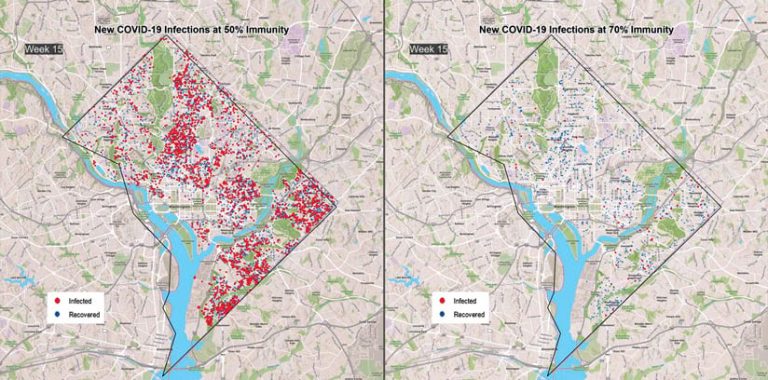City, state, and federal health officials are leading the effort to increase confidence in COVID-19 vaccines throughout the United States. Their goal is to get enough people vaccinated so that communities reach immunity levels that make it possible for people to safely get back to their prepandemic activities and ways of life.
Achieving this objective requires developing tools that clearly communicate the benefits of the COVID-19 vaccines. Leaders across the country can then use those assets to encourage people in their communities to get vaccinated.
Esri startup partner Epistemix used a computational simulation to model future COVID-19 infections in Washington, DC, over a 15-week period based on how many people receive vaccines and whether they are partially or fully vaccinated. The results are easy to visualize and understand—and they’re also convincing.
Challenges in Persuading People to Get Vaccinated
The messaging for encouraging people to get vaccinated against COVID-19 might seem straightforward: just tell people where and when to get their shots.
But public understanding of and confidence in the COVID-19 vaccines varies tremendously across cities, counties, and states. Moreover, individual communities have diverse demographic and cultural groups that interpret official guidance differently. Epidemiology is a complex topic that draws on a wide array of disciplines, from microbiology to sociology. So officials must balance all these factors as they endeavor to increase vaccination rates.
One powerful way to communicate the effectiveness of the vaccines is to show side-by-side scenarios of the spread of COVID-19 infections based on levels of population immunity. By comparing forecasts of how COVID-19 spreads at different levels of immunity over the same geographic area and time frame, officials can clearly present to community members the specific collective impacts of their vaccines.
It’s a lot more compelling to see what getting the shot could do for your family, friends, and neighbors than to try to interpret abstract statistics.
Visualizing Disease Spread Around Washington, DC
Epistemix used its platform to build a model that simulates the impact of varying levels of COVID-19 immunity in Washington, DC. This platform has been employed to forecast both infectious and noninfectious diseases for groups such as the World Health Organization (WHO), the RAND Corporation, the Centers for Disease Control and Prevention (CDC), and the State of Indiana. The simulation incorporates the latest public health data, calibrates it to local conditions, represents every person and place in the area with statistical accuracy, and uses realistic social dynamics.
A team of epidemiological modelers at Epistemix ran the simulation for COVID-19 in Washington, DC, and then exported the data from Epistemix’s platform to ArcGIS Online. This enabled them to visualize how the disease would spread around the city under various conditions.

The results revealed a stark difference between reaching 50 percent and 70 percent population immunity. In the figures above, every red dot represents an infected person, while every blue dot represents a person who has recovered from infection. The dramatic reduction in COVID-19 infections is clear if just 20 percent more of the population of Washington, DC, gets vaccinated. Fewer people get infected with the disease, which means fewer people end up hospitalized, and fewer people die. The city and the economy can open back up, and life can start getting back to normal.
But if people delay or refuse to get vaccinated and Washington, DC, stalls at 50 percent immunity, then successive waves of the disease will continually put residents at risk. This would likely lead to additional lockdowns and activity restrictions.
Grounded in the best epidemiological data available, these visualizations paint a precise and compelling picture of why residents of the US capital should get vaccinated as soon as they are eligible—and encourage others to do the same. People can see the direct impact of their vaccination decisions on the communities in which they live—what it means for their families, friends, neighbors, coworkers, schools, and local businesses.
By showing people how they can contribute to reopening instead of just telling them what to do, health officials invite those they serve to actively participate in the solution.
What It Takes to Get More Shots in Arms
Combining simulations with location intelligence to create powerful visuals that reveal real-world impacts can help officials, like those in Washington, DC, accelerate COVID-19 vaccine uptake in their areas.
Enabled by ArcGIS technology, Epistemix’s tools synthesize detailed information—current vaccination levels, the effectiveness of vaccines, variant strains of the virus, vaccine hesitancy rates, evolving social distancing rules, and mobility considerations—into actionable visualizations that make sense to a diverse audience of stakeholders. This is what it takes to get shots in arms.
Epistemix’s model for Washington, DC, is currently available in ArcGIS Marketplace and is already being replicated for other areas. The company has run similar simulations for cities including San Francisco and Miami, states such as Michigan and Indiana, and events like the Erie County Fair and the Chicago Marathon. Funding for this and other vaccine confidence data is available under the American Rescue Plan Act of 2021, section 2302.
Beyond COVID-19, location-based computational modeling can provide unique insights on health equity, chronic health conditions, and precision public health. And although health officials face historic challenges as the world combats the COVID-19 pandemic, they have better tools at their disposal than ever.

